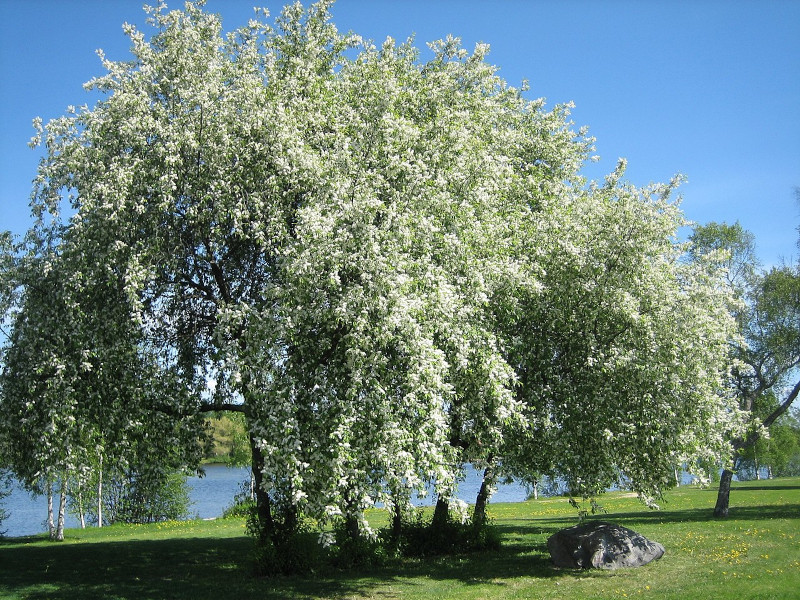
Bird Cherry Facts
- This lovely product of botanical evolution is most frequently referred to by the attention-grabbing common name of Bird Cherry. The amazing plant also has several other general titles. These include the terms of hagberry, hackberry, or the Mayday tree.
- But, within the scientific community it’s possibly better known by its technical moniker. Fortunately for the layperson, that’s an extremely simple epithet, at least as such things go. That’s true since the flora holds the official tag Prunus padus.
- The Angiosperm received that designation due to the efforts of Carl Linnaeus. The eminent Swedish zoologist accomplished the first acknowledgement of it as a separate and distinct species. He achieved that scientifically noteworthy deed in 1753.
- The gorgeous flora is also notable for several reasons. It possesses an extensive habitat range, for one. Because of the extent of that territory, however, minor divergence occurred. Due to that, science currently recognized two varieties of the flora.
- Thankfully, the Bird Cherry appears to be maintaining a population base that’s both highly stable and sufficient. This pleasant state also seems to hold true across its entire range. Accordingly, the IUCN now lists the marvel of Nature as Least Concern.
- It nevertheless still faces the same potential threats to its continued existence as all forms of life on earth today. Most of these stem from the actions of mankind. Among others, these include the related perils of habitat loss and ongoing climate change.
Related Articles
Bird Cherry Physical Description
One of the most fascinating traits of the fascinating Bird Cherry is its versatility of formation. That’s because this visually pleasing plant develops in differing forms. Depending on multiple factors, it matures as either a large shrub or a type of small, deciduous tree.
In either version, though, the flora manifests the mainly the same basic patterns of development. Younger specimens display an overall conical shape. As these mature, however, that changes. With age, most typically alter this to a more rounded general shape.
Due to its variations in structure, it presents several types of trunk design. When it grows as a tree, each example usually produces several thick, mostly upright trunks. As a shrub, though, it produces a single one, albeit one with an extremely curvy and branching design.
Yet, both versions display the same pattern regarding the bark of tree. In most instances, this aspect of the flora manifests a dark shade of gray. Lighter hues sometimes occur, however. But, in all forms of the amazing Angiosperm, the bark remains smooth in texture.
At maximum known growth, the Bird Cherry measures approxmately 82 ft (25 m). Most do not quite reach that height, though. Its leaves usually appear with an extended oval shape. This foliage also has serrated edges, with pointed tips, and shows a medium green color.
Yet, it’s the flowers that generally garner the most attention. The species produces these at the ends of short stalks. These also appear in large clusters. Each has five petals, and measures 0.31 – 0.59 in ( 8 – 15 mm) across. Petals are white, but the center shows yellow.
- Kingdom: Plantae
- Phylum: Tracheophyta
- Class: Magnoliopsida
- Order: Rosales
- Family: Rosaceae
- Genus: Prunus
- Species: P. padus
Bird Cherry Distribution, Habitat, and Ecology
The intrepid Bird Cherry evolved as endemic to a broad expanse of the surface of the earth. The full extent of that zone of habitation defies belief for some people, though. That’s because the botanical marvel developed as native to sections of both Europe and Asia.
In Europe, the surprising member of the rose Family lives naturally in the northern, central, and eastern portions of the continent. Across the continent of Asia, however, it principally inhabits the central sections. That even includes the island nation of Japan.
Nature provided this remarkable creation with a respectable degree of flexibility regarding its choice of habitat type. That’s true since it grows naturally in a moderately wide range of different ecosystems. That gives it a fairly powerful evolutionary advantage.
Most of these consist of moist regions, with clay and sand, though. They include settings like along the banks of streams an inside lush forests. Yet, it’s also often seen in areas of grassy woodlands and next to fields. In all such areas, however, it tends to develop thickets.
The Bird Cherry typically produces its copious blooms in April. These achieve the majority of their pollination via the visitation of locally prevalent species of flies and bees. Fruits generally develop and ripen in August. These start as red in color, then change to red.
Despite the fact that the hard seed, leaves, and stems are mildly toxic, it plays a vital role in its local ecosystems. The nectar of its flowers nourish large numbers of insects. Though bitter in taste, the fruit itself is edible. Birds especially love to dine one these in quantity.
Species Sharing Its Range
Check out our other articles on 5 Woefully Rare Woody Shrubs, Eurasian Brown Bear, Mount Vesuvius, East African Lowland Honey Bee, Knysna Seahorse, Weka, Mangrove Monitor
